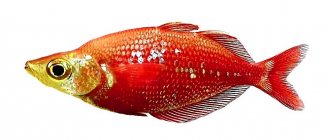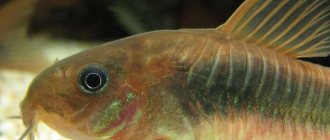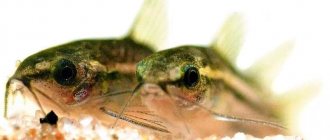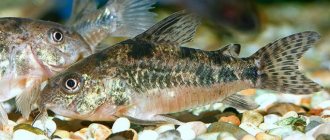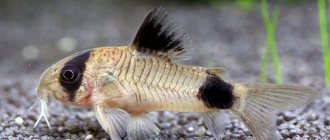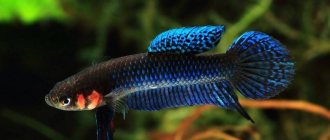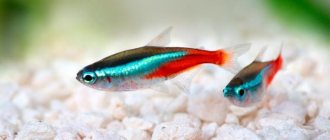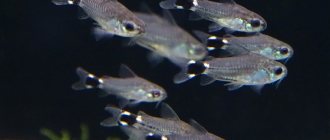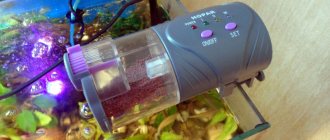Description
The speckled Corydoras is the most common catfish of the genus Corydoras.
Its main competitors are the panda catfish and the bronze corydoras. These fish are small: males reach 6 cm, females - 7-2.5 cm in length. The body is light olive, appears squat, as if blue-green or ashen plates sparkle on it. There are inclusions scattered along the entire body, which are unique to each catfish. The back and fins have a pale brown color with spots, the belly has a golden color. Males are distinguished by a sharp, triangular dorsal fin, females by a rounded fin. On the upper jaw there are two antennae-processes, with the help of which the speckled catfish finds food at the bottom of the reservoir. The fins have pointed spines that prevent potential predators from swallowing them. When replanting, use a special net made of thick fabric so that it does not get tangled in the threads. Watch how a catfish searches for food in the ground.
Fish that live in the wild have brighter colors and different variations of spots than aquarium species. They are active at night, although they also appear during the day. They live in flocks, from 6 to 15 years, in an aquarium - from 3 to 5 years, depending on the acidity and temperature of the water. High to shortens the life of the corridor.
Speckled catfish also make an unusual sound when their pectoral fins move. Most often, fish make noise during the spawning period, or at the moment of fright.
Speckled catfish are adapted to swallowing atmospheric air. Rising to the surface of the water, they capture a portion of air, which will later dissolve in the intestines. If this happens often, it is better to check the aeration of the aquarium; it is likely that the fish do not have enough dissolved oxygen.
Conditions of detention
Maintaining and caring for corridors is not difficult. It can adapt to large and small aquariums, where there is a company of the same catfish. Its neighbors in the home can be fish such as barbs, killfish, zebrafish, dwarf cichlids and tetras, livebearers, guppies, neons, swordtails (swimming in the middle and upper layers of water). The speckled catfish feels comfortable in cool water, so warm-water inhabitants of the underwater world will not take root with it. He will not tolerate being in the vicinity of large and aggressive fish that are not averse to hunting him.
Speckled catfish lives in the lower layers of water, at the bottom. The contents assume the presence of fine soil, sand or gravel of a dark color. You can place live or artificial vegetation, floating plants and driftwood in the aquarium to diffuse light and provide good cover.
Caring for corridors requires a constant temperature regime. Corydoras paleatus are cold-loving fish, the optimal temperature for which is 22-25°C, so in summer the water needs to be cooled. They can tolerate water hardness above 7.0 pH, although soft water with low acidity up to 10 Gh is preferable. Moderate aeration of the aquarium is required. These fish do not like frequent water changes; once a week is enough. For 3-4 individuals, the aquarium capacity is 25 liters or more.
Due to excess salts and nitrates in the water, rotting food at the bottom of the aquarium, and temperature changes, the speckled catfish can get sick. The main condition is to regularly change the liquid to fresh one and clean the bottom of the aquarium. If you notice a sick catfish, immediately remove it from the general aquarium, temporarily moving it to another, isolating it from healthy fish.
Watch the speckled catfish spawn.
Feeding
The speckled catfish is not picky about feeding. They eat both live food and special tablets, dry food, granules, bloodworms and tubifex. They feed at the bottom of the aquarium, so you need to carefully ensure that enough pieces of food get there. Sinking pieces are ideal. Remnants of food floating on the surface of the water will be picked up by other types of fish, so when choosing food you need to focus on its weight.
Compatibility with other fish
Corydoras are distinguished by their calm nature, and therefore are excellent neighbors for most species of fish. It is worth considering that they lead a bottom-dwelling lifestyle. Therefore, for their comfort, it is better not to have other catfish. The best option is animals that swim closer to the surface or in the middle layers.
In the photo are Corydoras, Ancistrus stellata, Siamese algae eater.
For example, you can buy barbs, gourami, cockerels, zebrafish, guppies, mollies, swordtails and platies as neighbors. Rasboras, tetras, ternations, neons, and minors are also suitable. Perhaps they will get along with goldfish, koi carp and some types of cichlids (the most peaceful ones). But here you need to be careful and watch so that problems do not arise. If the fish do not get along, then it is better to seat them.
Reproduction
Speckled catfish breeding in aquariums began about 100 years ago. The fish are undemanding and easily reproduce in captivity.
Corydoras reach sexual maturity at the age of eight months.
To breed catfish, you need to prepare a separate aquarium with a volume of at least 10 liters. Replace the soil with plants and strengthen them with stones at the bottom. Place the aquarium in a sunny place, increase aeration. The water should be 3-5 degrees colder than usual, this imitates the rainy season - the natural breeding time of speckled fish.
Place one female and 2-3 males in the prepared spawning tank.
To start breeding speckled catfish you need to change your diet. As an impetus for spawning, live food rich in protein is preferred.
Adults must be removed immediately after spawning, as they are capable of eating their own eggs.
Differences between a female and a male
Sexual differences between males and females are pronounced. You can determine the sex of a fish based on several characteristics:
- females are larger in size and have a more rounded abdomen;
- the dorsal fin in males is larger in size, and the anal fin has a more pointed shape;
- The male corydoras is variegated and significantly brighter than the female.
Spawning
Readiness for spawning is shown by the reddened abdomen of the female. Aquarium catfish show great activity and mobility.
The male begins to stimulate the female with the help of his antennae. Then he takes an L-shaped position opposite the partner’s mouth and releases a portion of milk. With its help, the eggs located in the pelvic fins will be fertilized and then glued to the selected and cleaned place.
Any surface is suitable for masonry - glass, plant leaves, filter. The female lays several eggs at a time. The process is repeated.
Spawning of speckled catfish lasts about an hour. The clutch size reaches 200–400 eggs.
Fish usually spawn in the morning or afternoon.
Caviar
Corydoras fry reach 4 mm and increase in height by 1 cm per month.
When the fry hatches, feed it small-sized live food or industrial food, ground to a dust state. Cyclops, micromera and brine shrimp larvae are suitable as food. For babies, change the water more often.
Prices
In pet stores the price tag is higher, on bulletin boards it’s cheaper.
| Size(cm) | Starting price (Russian rubles) |
| Up to 2.5 | 55 |
| 2.5–4 | 75 |
| 4–5 | 90 |
| 5–8 | 180 |
| 8–11 | 200 |
| 11–15 | 250 |
| 15–18 | 300 |
| 18–20 | 400 |
| 20–25 | 500 |
| More than 25 | 1000 |
Appearance
The speckled catfish or Corydoras paleatus belongs to the genus Armorata. Its body is short, convex on top, and its abdomen is flat. This species is scaleless.
The skin is covered with a large number of bony plates arranged in rows and overlapping each other.
The small dorsal fin of the female is round in shape; in males it is pointed. The adipose fin, like all armored catfish, is equipped with an impressive spine in its front part.
The color of Corydoras is grayish-olive, the back is dark, and the belly is yellowish. Small dark spots of irregular shape are scattered throughout the body.
The fish has a lower mouth, which helps it collect from the bottom of the reservoir. On the upper lip you can see two pairs of antennae, which are organs of touch and help it navigate in muddy water.
Sexual dimorphism in these fish is very pronounced; it is impossible to confuse a male and a female.
Females are large in size, sometimes exceeding males by almost 2 times.
Typically, if the male is about 5 cm long, the female can grow up to 9 cm.
Speckled catfish are very undemanding and unpretentious. That is why it is recommended to purchase this fish from the underwater world.
Aqua parameters
. The composition of the water usually does not affect the well-being of Corridors. There are values that are comfortable for them:
- hardness - up to 30°,
- acidity – 6–8,
- temperature - 20–25°C.
However, these bottom inhabitants tolerate less hard water well, as well as a wide temperature range from 2 to 35°C.
Aeration
. These are inhabitants of small bodies of water, where the water in the heat is almost devoid of oxygen. But catfish are not afraid of this. They swallow air from the surface and breathe it. Thanks to the presence of intestinal respiration, fish survive where other species cannot exist.
Speckled catfish cannot tolerate salt in water.
Salt cannot be used for its treatment and preventive measures, since even after a short stay in salt water, this fish usually dies.
Can sizes
. For catfish it is not necessary to purchase a spacious aquarium. A volume of 40 liters is quite enough. The pond is designed so that fish can hide.
Vegetation
. Aquatic plants are suitable for this purpose. You just need to make sure that they do not cover the surface of the water excessively. Nothing should prevent the catfish from gaining air.
Decor
. We must not forget about other shelters: stones, snags, grottoes. It is better to take medium and shallow soil so that these fish can turn it over, looking for food.
Of course, if there is excess dirt at the bottom, the catfish will muddy the water, so you can’t do without a good filter. You also need to regularly clean the bottom of the reservoir.
Lighting
. To make the catfish comfortable, the lighting is not very bright.
Compatibility
. The corridor in the aquarium should never be lonely, because catfish are schooling fish. They feel great in the company of 5-6 individuals. These are calm inhabitants of indoor ponds, so all peaceful species of not too large sizes get along well with them: Swordtails, Danios, Angelfish, Neons, small Cichlids.
With good care, Speckled catfish can live 8-10 years. And sometimes there are 15-year-old specimens.
The most common types
In amateur aquarium keeping, the following types of corydoras catfish are most often found:
Speckled catfish
The most widespread representative of Corydoras is the speckled one. Unpretentious, beautiful, active and hardworking - in short, everything an aquarist needs! It is these qualities that made the speckled corydoras one of the most popular aquarium catfish.
Adolf
A small, very cute catfish with a bright orange cap on its head and a well-defined black stripe on its back. The body length does not exceed 5 cm. In an aquarium, Corydoras Adolfa practically does not reproduce.
Arquatus
Also known as two-lane. In natural conditions it lives in Brazil and Peru. The size of the arcuatus is no more than 5 cm. The main body color is golden. A wide black stripe runs along the ridge.
Julie (leopard)
A very beautiful and interesting catfish comes from Brazil. The main body color is silver-gray with dark spots forming patterns. The abdomen is uniform, light. The top of the dorsal fin is black. Julie's corridor is also known as leopard print.
Duplicareus
A distinctive feature of the species is a pronounced black stripe running through the eyes and the top of the back. It occurs naturally in Colombia, mainly in the Meta River. The body length of Duplicareus does not exceed 5 cm. The name translated from Latin literally means “one more”. Thus, scientists wanted to emphasize the similarity with Adolfi.
Golden albino
A very interesting albino catfish. The main body color is white-pink, the eyes are bright yellow with a well-defined red pupil. Natural habitat: South America and Brazil.
Nanus
The body is silvery with a characteristic black pattern. The forehead and part of the back are green or olive. The pattern on the sides forms three stripes. In nature, Corydoras Nanus is found in the eastern part of Brazil.
Trilineatus
A species very similar to Corydoras Julie. It differs only in the shape of the fins. In nature, trilineatus is found in Brazil and Peru. In the aquarium it occupies the lower, bottom level. Conditions of detention are the same as for all corridors.
Khabrosus
Miniature in appearance, the average size of the fish does not exceed 3 cm. Corydoras habrosus attracts with its striking coloring of chaotically located black spots. It is advisable to keep this species in a flock of 6 or more individuals.
Hastatus
A miniature catfish no larger than 2.5 cm in size. Hastatus is also known as the dwarf or sparrow. Very easy to keep, peaceful in appearance. It feels best in a flock of 10-15 individuals.
Shterba
A type of corydoras measuring no more than 5 cm. Thanks to the chaotic dot pattern, it looks very unusual and decorative. Shterba is recommended for school keeping. Angelfish, tetras and other small fish of a peaceful disposition can be used as neighbors.
Golden (bronze) corridor
Golden catfish have arrived from Venezuela and Trinidad to our aquariums. The color of representatives of this subspecies can range from gray-golden to rich bronze. In an aquarium, the fish grows up to 7 cm.
Panda
The resemblance of this catfish to the Asian bear is obvious. The birthplace of this species is the Ucayali River in Peru. Grows no more than 5 cm in an aquarium
It is very important for pandas that the water temperature in the aquarium does not fall below 17 degrees
Habitat
Despite the fact that albino forms often appear in wildlife, here they most often quickly become victims of predators. But in home aquariums, the fish will find real peace, because albino corydoras have no natural enemies here.
The historical homeland of Corydoras is South America. They are widespread in the Amazon, La Plata, and Parana river basins. Catfish prefer standing or slowly flowing bodies of water: tributaries of rivers, ponds, swamps. They live in flocks. During the day, the fish hide in dense thickets of aquatic vegetation, and at night they go out in search of food: worms, crustaceans, insects.
Conditions for keeping Corydoras in the aquarium
Wild catfish live in small lakes with slow-moving water, streams or reservoirs formed during the rainy season, which dry up during periods of lack of rainfall. Width 100–200 meters, depth 0.5–2.0 meters. The reservoirs are surrounded by coastal plants. At the bottom there is sand, silt, tree branches and fallen leaves, which release tannins into the water. This makes the water cloudy. Parts of plants, remains of worms and insects, and freshwater crustaceans were found in the stomachs of wild catfish. Active at dusk. They like to swim in schools of 3–15 fish.
To keep four catfish you need a 40–50 liter aquarium with a wide rectangular bottom. It is placed in the darkest place in the room, out of direct sunlight. A layer of fine sand or pebbles, quartz, basalt with a particle size of 0.5–1.5 cm is poured onto the bottom of the aquarium in a layer of 2–3 cm. Large oval stones are placed. For shelters, driftwood taken from a pond or river is used. After checking whether the driftwood sinks or not, it is washed, boiled for 1.5 hours and, after cooling, placed on the bottom. Leave free space from plants for feeding catfish. The soil is preferably soft so that the catfish do not damage the whiskers with which they find food.
Video: leopard corydoras swallow grains of sand from the ground and throw them out with their gills
When catfish suck up soil particles while eating, injury and illness are possible.
Plants for an aquarium with Corydoras:
- Hygrophila angustifolia;
- Java moss;
- Anubias (shade-tolerant);
- cabomba;
- Vallisneria;
- pinnate;
- hornwort (catfish eat it).
The prepared plants are tied to heavy stones with fishing line so that they do not float up and catfish cannot pull them out of the ground. For decoration, prepared coconut shells are placed on the bottom of the aquarium. Adding boiled fallen oak leaves will bring the composition of the water closer to natural, but cloudiness makes it difficult to observe the corydoras.
The water temperature is not lower than 19°C, the upper limit is 26°C. The lifespan of corydoras decreases if kept at higher temperatures. The aeration of the water is constant, but not intense, so as not to frighten the fish. Every three days, change up to a quarter of the volume of water in the aquarium. The lighting is dim. The top cover glass covers half of the aquarium, since catfish often swallow air from the surface of the water. Water acidity pH 6.0 – 6.8. Water hardness is neutral. Salt - less than 1 g per liter. Water purification with a filter is mandatory.
It is better to feed Corydoras once a day, in the evening. Although they learn to eat during the daytime. The meal lasts 30–45 minutes, after which the remaining food is removed.
Live food for Corydoras:
- bloodworm;
- tubifex;
- freshwater crustaceans (Cyclops and Daphnia);
- nematode aulophorus (mosquito larvae);
- ciliates;
- rotifer.
You cannot feed corydoras with brine shrimp, which contain a lot of salt in their bodies. Catfish are freshwater fish and do not feed on brine shrimp in the wild. Salt from eaten brine shrimp destroys the digestive system of corydoras, reduces immunity and promotes bacterial infection.
In the absence of live food, catfish happily eat dry food in pellets, tablets and granules. Dry flakes do not sink well, and corydoras eat from the bottom of the aquarium. Preferred food for bottom fish. It is convenient to place dry and live food in a closed feeder with holes through which the fish will tear off pieces. After eating, it is easy to lift it up and remove the leftovers.
Adviсe
- When changing water, also clean the soil. Pandas don't like pollution.
- Fish prefer dark-colored sand to light-colored sand.
- Dry oak or beech leaves are beneficial for the health of catfish.
- Catfish will get along with all peaceful fish and even shrimp.
- It is optimal to use Java moss for spawning.
- Some sources indicate that catfish can live in a small container. This will cause discomfort to the fish, adhere to the recommended parameters.
- In fry up to 3 months the color is not expressed. Don't go wrong with the breed when purchasing.
Peaceful, hardy and easy to keep, the panda catfish is suitable for beginner aquarists. Thanks to its unusual color, the catfish has confidently occupied a niche among popular fish.
Sources
- https://rybkies.ru/rybki/som-koridoras.html
- https://RybkiVBanke.ru/akvariumnye-rybki/koridoras
- https://MrHvost.com/vse-vidy-koridorasa
- https://fishcam-store.ru/rybki/som-panda.html
- https://sazhaemvsadu.ru/koridorasyi-soderzhanie-i-razvedenie/
- https://aquaspecial.ru/akvariumnye-rybki/som-koridoras
[collapse]
Choosing the right healthy catfish
Corydoras catfish have a strong immune system. Experts have not identified any diseases inherent in these aquarium fish. Corridors are able to withstand sudden changes in environmental conditions.
However, it is prohibited to use salt (sea salt, table salt) for pest prevention purposes.
When purchasing corydoras, take a closer look at the behavior of the selected specimen:
- It is not recommended to take fish that lie on the ground and do not respond to external stimuli.
- A healthy catfish is active, quickly swims to the surface, takes in air, and then easily swims to the bottom. The sick individual moves hesitantly and chaotically, falls over on one side or lies motionless on the bottom.
Signs of sick fish:
- stuck together fins;
- cloudy eyes with a film;
- damage to the antennae;
- sore or red gills.
Red-brown spots are an indicator of the presence of bacteria or fungi in the fish’s body. The sunken abdomen of the catfish indicates that it is exhausted or infected with helminths. A bulging abdomen may be the cause of some disease.
Thus, Corydoras catfish are schooling, cheerful and interesting fish. If you care for them properly, they will delight their owners for 15 long years.
Reviews
Due to its ease of care, resistance to disease, and peaceful nature, the catfish will be a wonderful gift for both a beginner and an experienced aquarist. Even looking after 4-5 individuals, which are recommended to be launched at the same time, will not be difficult. In addition, Corydoras can pick up food after other fish, which is what earned it the nickname - the aquarium scavenger. You can buy catfish at any pet store, thanks to the abundance of species, everyone will find something of their own. With proper care, this cheerful and active inhabitant of the aquarium will delight its owner for many years.
Do you want to buy Corydoras catfish for your aquarium? Share in the comments!
What diseases are they susceptible to?
If these pets are not provided with suitable living conditions, they may become ill. Most often these are bacterial and fungal infections. Corydoras often suffer from fin rot and helminthiasis. Some aquarists experience poisoning due to excessive concentrations of nitrates, phosphates and other compounds.
Fungus
It can be identified visually by various spots, growths and plaque on the body of the fish. In this case, the treatment takes place in a special jigging container. Among the medications you can choose potassium permanganate (5-minute baths), furatsilin (1 g per 10 l). You also need to be careful with the last drug. The fish is placed in the container daily, but for no more than half an hour. Under no circumstances should you use salt, as these animals cannot tolerate salinity in the water and die quickly.
Poisoning with nitrogen compounds
If the fish often begins to stay near the surface and gasp for air, then it means that there is an excess of nitrates, phosphates and other harmful substances in the water. Ideally, you should test your water for the presence of these compounds.
The solution to the problem is simple - you need to make a replacement. First, you can replace half the volume of the aquarium, and then you should monitor the behavior of the fish and the concentration of nitrogen compounds.
Feeding
Under natural conditions, corydoras feed on insects and their larvae. In the aquarium, catfish are practically omnivorous. Like most bottom-dwelling fish, they feed mainly in the dark. You can give them catfish tablets at night. You can also use bloodworms, daphnia, and tubifex for feeding.
If the aquarium contains more active and agile neighbors together with corydoras, you need to make sure that the catfish have time to eat fully.
Speckled Corydoras, or Speckled Catfish (Corydoras paleatus)
Speckled Corydoras or Speckled Catfish (Corydoras paleatus) is a fish of the Callichthyidae family. The habitat of the speckled corydoras is South America (Southeastern Brazil, La Plata, the Buenos Aires and Montevideo regions, Paraguay and Uruguay. They usually live in silty, slow-flowing and stagnant waters with dense vegetation.
The body is small in size with a convex back, covered with a shell, which consists of two rows of bone plates located on the sides. Lower mouth.
There are two pairs of sensitive whiskers on the upper lip. The dorsal fin is high. The body is light brown with numerous dark spots. The abdomen is pinkish with a golden tint. Breeders have bred an albino form of fish with a pink body color and a veil form.
Sexual differences: the male is smaller and slimmer than the female, the color is paler, the spots on the body are smaller, the dorsal fin is high and pointed at the end. Females have a shorter and rounded dorsal fin.
The male grows up to 4-6 cm in length, the female up to 7 cm.
Life expectancy in an aquarium is 8-10 years.
Baby catfish is a peace-loving schooling fish. It is advisable to keep at least 6 fish in a school. Suitable for keeping in a community aquarium. Gets along well with various types of peace-loving fish.
They are most active at dusk. It lives in the bottom layers of water.
To maintain the speckled corydoras, you need an aquarium of 10 liters. per one individual. As a soil, it is advisable to use rolled river sand or fine gravel, poured in a thick layer (catfish like to rummage in it in search of food).
Speckled catfish prefers twilight lighting. The aquarium should have shelters that create shade from thickets of broad-leaved aquarium plants and natural driftwood, and caves made of stones.
Since this fish can breathe atmospheric air, it is necessary to leave free access to the surface of the water.
It happens that a catfish swims into a narrow gap and, unable to get out of it, dies. This circumstance must be taken into account when decorating the aquarium.
Speckled Corydoras does not tolerate salt and medications including malachite green.
Tolerates a short-term decrease in temperature to 15-18 ° C, does not die at 3 ° C and can survive even when frozen into ice.
Aeration, filtration and weekly water changes of up to 30% of the aquarium volume are required.
Speckled Corydoras eats dry, live (tubifex, bloodworm, coretra) and plant food. They collect food from the bottom, but can rise to the surface of the water and swallow food. When actively searching for food, they constantly dig into the ground, stirring up bottom sediments (therefore, powerful filtration is necessary).
To breed speckled corydoras, you need a spawning aquarium with a volume of 30-50 liters, with dim lighting. Soil is not required. A large-leaved plant can be planted in the spawning tank.
Water parameters for spawning: hardness up to 15°, pH 6.0 - 7.0, temperature 19 - 22°C. Good aeration is needed.
The spawners (one female and 2-3 males) are placed in the spawning tank in the evening, and they must be frequently and abundantly fed with live food. Spawning begins with the first rays of the sun (it is better to place the aquarium near a window). As stimulation, you can reduce the water temperature by 2-3°. Spawning lasts several hours. At the beginning, the males actively pursue the female. Then the female takes the male’s milk into her mouth, smears it on the substrate (any well-lit surface) and glues the eggs to it. Then the process is repeated. The female lays up to 250 white-transparent eggs. After spawning, the producers are removed.
The incubation period lasts 5-6 days (at a temperature of 23-25°C). After the fry appear, the water temperature is reduced to 20-24°C. Starter food: “live dust”, Artemia nauplii, rotifers, then catfish tablets and finely chopped tubifex. In a nursery aquarium, it is advisable to provide the fry with weak aeration. With weekly water changes and good nutrition, the fry grow quickly.
The mottled corydoras reaches sexual maturity at the age of 8 months.
Synonyms: Speckled corydoras, speckled catfish, straw shellfish, marbled catfish, simple catfish, corydoras paleatus.
general characteristics
Corydoras are relatively small representatives of their genus. Unlike other catfish, they grow no more than 10 cm, but often their growth stops within 3-7 cm. Females are larger than males. Mostly there are individuals of olive-gray color.
The habitat of these fish is the waters of South America, namely Uruguay, Paraguay and Brazil. They are found in various rivers, since Corydoras are represented in a wide variety of species. Some species prefer soft and fresh water, while others live in silty areas. By nature, these are very hardy and strong catfish, since they can easily withstand temperature changes and even survive severe droughts.
These are truly amazing animals. Despite their size, they are able to fend for themselves. On the back of these catfish there are bone plates, because of which they are not afraid of attacks from aggressive neighbors.
These fish have a large head and a flattened tail. Their mouth is located below, so they pick up all their food directly from the ground. In addition, they have whiskers located near the mouth to search for food. Thanks to it, they can easily dig into the ground and find leftover food.
Males have a pointed fin, while females, on the contrary, have a rounded fin. The pectoral fins also have sharp edges. Therefore, it is better to catch these pets during transplantation not with a net, but with a jar. To do this, fill the container with water, lower it to the bottom and throw food there. A curious Koridoras will swim up for food and then you can safely remove it right from the jar.
Fish have two types of breathing. The first is through the gills, the second is intestinal, when the animal grabs air from the surface.
We recommend reading the article: The strangest and most unusual aquarium fish
